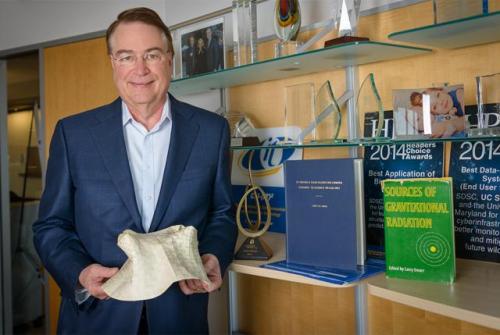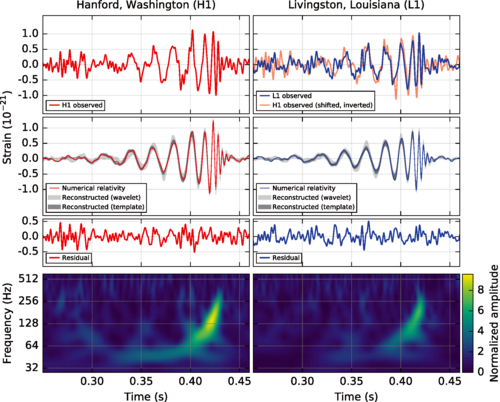
In his doctoral dissertation at the University of Texas, Austin in 1975, CSE professor Larry Smarr developed a computational method for solving Albert Einstein’s equations of general relativity. Smarr’s PhD thesis, “The Structure of General Relativity with a Numerical Illustration: The Collision of Two Black Holes,” showed how computers could reveal the “generation of gravitational radiation from the formation of black holes,” he wrote in his dissertation. “The particular case of two non-rotating black holes colliding head-on is chosen as a test case for the computer.”
 Forty years later, Smarr – now director of the California Institute for Telecommunications and Information Technology (Calit2) and the Harry E. Gruber professor of Computer Science and Engineering in the Jacobs School of Engineering at the University of California, San Diego – was inundated with messages following a Feb. 11 announcement by the National Science Foundation at the National Press Club. A global consortium of more than 1,000 scientists had, for the first time, detected evidence of ripples in space-time known as gravitational waves. The waves were produced by the merger of two black holes in space some 1.3 billion years ago, but passed through the Earth only last September. The waves were recorded using the Laser Interferometer Gravitational-Wave Observatory (LIGO) barely one day after the observatory became operational following a major upgrade to make the detectors more sensitive. The devices – located in Louisiana and Washington State – are now referred to as Advanced LIGO. “These gravitational waves induced fluctuations in length of Advanced LIGO’s two 4-kilometer laser beams that are smaller than one-thousandth the diameter of a proton,” said Smarr.
Forty years later, Smarr – now director of the California Institute for Telecommunications and Information Technology (Calit2) and the Harry E. Gruber professor of Computer Science and Engineering in the Jacobs School of Engineering at the University of California, San Diego – was inundated with messages following a Feb. 11 announcement by the National Science Foundation at the National Press Club. A global consortium of more than 1,000 scientists had, for the first time, detected evidence of ripples in space-time known as gravitational waves. The waves were produced by the merger of two black holes in space some 1.3 billion years ago, but passed through the Earth only last September. The waves were recorded using the Laser Interferometer Gravitational-Wave Observatory (LIGO) barely one day after the observatory became operational following a major upgrade to make the detectors more sensitive. The devices – located in Louisiana and Washington State – are now referred to as Advanced LIGO. “These gravitational waves induced fluctuations in length of Advanced LIGO’s two 4-kilometer laser beams that are smaller than one-thousandth the diameter of a proton,” said Smarr.
[Pictured above: Calit2 Director Larry Smarr holds his 1976 handmade model of the curved space caused by two black holes just before they collided. Each paper strip of the coordinate grid was printed out with its distorted shape accurately represented. Then the strips were woven together by hand. One could consider this an analog precursor to today’s digitally driven 3D printers. Next to Smarr are his Golden Goose Award, his blue PhD dissertation, and the book he edited on the 1978 workshop on Sources of Gravitational Radiation. Photo by Alex Matthews/Qualcomm Institute.
The power radiated in gravitational waves by the collision of the black holes (merging black holes estimated to be 29 and 36 times the mass of the sun, respectively) was 50 times larger than the power emitted by all the stars in the universe and yet would have been invisible to humans on Earth without LIGO.
“It’s hard to overstate how historic the moment is,” Smarr told HPCwire yesterday. “Think about all of the amazing astronomical objects we’re studying with radio astronomy, x-ray astronomy, ultraviolet astronomy, infrared astronomy or optical. Those are all just parts of the electromagnetic spectrum. This is an entirely new spectrum, from end to end, with as diverse sources as the electromagnetic spectrum that we have been working on since Galileo.”
The hard evidence of gravitational waves came almost exactly 100 years after Einstein’s general theory of relativity proposed the concept of space-time and distortions in what are now known as gravitational waves. Einstein believed, however, that the waves would be so small and fleeting that they would never be detected experimentally. “The National Science Foundation began funding development of LIGO some 30 years ago, even though they knew that the first version of the ‘telescope’ could not be powerful enough to make this observation,” said Calit2’s Smarr. “It cost more than a billion dollars to get this far over 30 years, and it demonstrates how important long-term research funding is to our understanding of physics and the universe.”
 [Pictured at left: Advanced LIGO detector in Livingston, Louisiana, registered the two-black-hole collision’s gravitational waves at 9:51 UTC (2:51 Pacific time) on September 14, 2015; seven milliseconds later the sister detector in Hanford, Washington, recorded the same signal. The signals at each site are depicted below.]
[Pictured at left: Advanced LIGO detector in Livingston, Louisiana, registered the two-black-hole collision’s gravitational waves at 9:51 UTC (2:51 Pacific time) on September 14, 2015; seven milliseconds later the sister detector in Hanford, Washington, recorded the same signal. The signals at each site are depicted below.]
Smarr recalls that after his Ph.D., as a Junior Fellow at Harvard, he organized an international workshop in Seattle in 1978. The workshop explored “Sources of Gravitational Radiation,” and Smarr edited a book based on the proceedings (still available on Amazon). The first article in the book was by Ray Weiss, the researcher at the NSF press conference yesterday who invented the gravitational-wave laser interferometer, and the third article was by Kip Thorne, who was also at the press conference (and with whom Smarr first met in 1970).
“We all knew in 1978 how difficult the problem was going to be – both to solve computationally the nonlinear coupled Einstein equations for the collision of the two black holes and the subsequent generation of gravitational radiation, as well as to build the most sensitive measuring instrument in human history,” noted Smarr on Thursday. “However, I was always confident that technology would eventually improve to where it would be sensitive enough to detect what was reported yesterday.”
Smarr’s work on black holes made him realize how revolutionary supercomputers were going to be in a wide array of disciplines. So he pulled together a team of pioneering researchers and submitted an unsolicited proposal to NSF in 1983 to create a university-based supercomputer center. “My research led me to understand that academics needed access to supercomputers,” he noted. His was the first proposal to the NSF, closely followed by one from Sid Karin at General Atomics in 1984. The eventual result: NSF funded the National Center for Supercomputing Applications (NCSA) at the University of Illinois, Urbana-Champaign, where Smarr became the founding director. Sid Karin became the founding director of the San Diego Supercomputer Center (SDSC). Karin is an emeritus professor of computer science at UC San Diego.
Smarr notes that for his research at UT Austin, supercomputing was in its infancy. He first used a CDC 6600, which had only less than a percent of the computing speed of today’s smartphone.
 [Pictured at left: Gravitational-wave event GW150914 observed at LIGO Livingston (right column) and LIGO Hanford (left). For details, see joint paper on “Observation of Gravitational Waves from a Binary Black Hole Merger” in Physical Review Letters, Volume 116, Issue 6, 12 February 2016.]
[Pictured at left: Gravitational-wave event GW150914 observed at LIGO Livingston (right column) and LIGO Hanford (left). For details, see joint paper on “Observation of Gravitational Waves from a Binary Black Hole Merger” in Physical Review Letters, Volume 116, Issue 6, 12 February 2016.]
By 1993, an NCSA video documented the work of Smarr and his relativity group, led by Ed Seidel, now director of NCSA. The video noted that Smarr and colleagues “foresee a time when the experimental and theoretical sides of relativity come together, a time when Einstein’s famous theory of general relativity can be both solved theoretically and verified experimentally.”
Smarr also envisioned the growth of the field of numerical relativity. “The only way to solve Einstein’s equations is to build a numerical laboratory in which we create artificial universes, and with computers, go in and do experiments on them,” he said in 1993. “The goal was to solve increasingly complex numerical black hole problems using these as building blocks toward a general solution of the Einstein equations.”
In the NCSA video, Smarr added: “When we get to the point where there really are experimental results in relativity and there are routine codes to solve the Einstein equations, then we will have a true science of general relativity.”
Now, that day has arrived.
Both SDSC and NCSA have continued to support research on gravitational waves, including one of NCSA’s current relativity researchers, Eliu Huerta, who is a co-author on the observational discovery published today online in Physical Review Letters (“Observation of Gravitational Waves from a Binary Black Hole Merger”). “There can be no better way to celebrate the first centenary of Einstein's prediction of gravitational waves,” said Huerta. “We can gladly say that Einstein is right, and that the beautiful mathematical framework he developed to describe gravity is valid even in the most extreme environments. A new era has begun, and we will be glad to discover astrophysical objects we have never dreamt of.”
“It’s nice when dreams come true,” observed SDSC director Michael Norman, telling Smarr after the NSF announcement, “it’s a day for you to savor.” Norman and Smarr had met 40 years ago at Lawrence Livermore National Laboratory, where Norman was a graduate student and Smarr was using Livermore’s supercomputers to do the first computations of black hole collisions.
The first-ever observation of two black holes merging is expected to win prizes for the science team behind it, but Calit2’s Smarr has already been honored for his early role in the field. In 2014 he received the Golden Goose Award, which honors scientists “whose seemingly obscure, federally-funded research had led to major breakthroughs in biomedical research, medical treatments, and computing and communications technologies. Smarr was cited for the long-term impact of his early work simulating black hole collisions on supercomputers, funded by NSF. That led to his successful proposal for a university supercomputer center (NCSA), which linked supercomputing centers that brought NSFnet – an early incarnation of the Internet – to university campuses, and soon after the first Web browser, NCSA Mosaic (later commercialized as Netscape Navigator and Microsoft’s Internet Explorer).
Learn more about Advanced LIGO.
Watch a 1993 video produced by the National Center for Supercomputing Applications.
Read the complete article in the Physical Review Letters.

